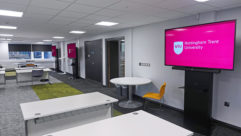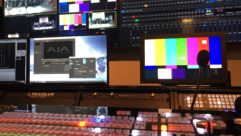Summer School Install
Jan 1, 2002 12:00 PM,
By Elaine Jones
At The George Washington University Law School, Washington, D.C., the Socratic method of teaching is heavily used. Teachers ask questions to lead students to new understandings of the law. But the school had a problem: Audio difficulties stood in the way of effectively using the method. Students could hear the teacher but could not hear the other students’ responses.
“We have eight large classrooms, and the goal was obviously not only to have the professor be heard by the students, but also to have the students heard by the professor and, more importantly, heard by each other,” explained Thomas Morrison, associate dean for administrative affairs.
GW turned to Polysonics Corporation to come up with a solution. The result was a $2.8 million renovation of the school’s facilities, the first such renovation since the mid-1980s. The renovation provides the school with state-of-the-art technology, improved classroom ergonomics, and greater uniformity within the building’s internal structure. The classrooms are located among adjoining buildings. The largest room has 180 seats. The next group of classrooms has about 125 seats per room, and the last group has around 90 seats per room.
“One of the main problems was integrating the infrastructure required to support the new technology,” said Robert Capozello of Polysonics, who provided the A/V system design. “The Lerner and Stockton buildings [were already built], and trying to get floor boxes and conduit installed was quite a challenge. Fortunately, the buildings were undergoing major renovations, and that made things a little easier. The other main hurdle was the time constraint,” said Capozello. The facilities had to be completely renovated during the 3-month summer break.
OPEN AND SHUT
“THIS WAS A FAST-TRACK PROJECT,” said Bob Burdett, president of systems integrator American Amplifier and Television Corporation. “It had a firm completion date that had to be met.” At the time the project was awarded, American Amplifier was in the process of installing several other large projects, including the new Miller Senate Office Building for the state of Maryland. American Amplifier began construction immediately after the last final exam on May 15 and completed 12 classrooms in time for the class arriving for fall 2001 orientation on August 13. The tight time frame on the project meant the integrator had to work at the same time as the general building contractors. “The biggest problem I found on this job, and in other jobs that are under construction, is that the completion date of the job is the same as the completion date for the construction company,” said Joe Parker, lead project engineer at American Amplifier. “The construction company cleans the rooms only just before their punchlist, which means the A/V company has little time to install all the projectors, cameras, equipment racks and other sensitive equipment. We tried to install as much as we could before the cleaning. But in our business, most of the equipment we install does not react well to dust and paint.”
TAKING THE STAND
ANOTHER MAJOR DESIGN ISSUE was the multimedia podium. The law school had specific ideas about how these lecterns should look and operate, and what technology had to be included. To assist in visualizing how the podiums would look in the classrooms, Polysonics prepared a 3-D animation for the school.
“We went to the site, took digital photographs of one of the existing classrooms, and then inserted the 3-D animation into the photographs,” said Capozello. This enabled the university to actually see what the podium would look like in the space, and it gave them a sense of what it would be like to stand behind the podium facing the classroom. “It was extremely helpful for the university and invaluable in the design process,” Capozello noted.
Podiums were custom-built by K-Mack Racks of Tacoma Park, Maryland. “The animation created by Polysonics provided a good visual representation of the shape and size but had no specific details,” said Keith Mack, owner. After several conversations with the staff at American Amplifier, Mack incorporated a number of changes in his lectern designs. “The main change was the addition of a doublewide, 12-space equipment rack, featuring a full pull-out for service access capability, located in the center of the lectern.” This was needed to provide a centralized, operator-friendly location for the frequently used display equipment.
Further complicating the design were the requirements for the units to also be electrically height adjustable; house a PC, keyboard and mouse; include an AMX touchpanel and a 15-inch LCD flat-panel display; and have a lockable drawer for security reasons.
Mack’s initial podium designs were too large for the space requirements. In many of the rooms, the lecterns were tightly located between a wall and the edge of a stage that stepped down, and there was not enough space to allow an instructor to present comfortably. “I went back to the drawing board and redesigned the lecterns in a 24-inch overall depth,” said Mack. “This gave me incredibly tight tolerances, no more than ⅛ inch of play room between any glides, doors, motors, etc., throughout the whole unit.” This change also mandated that the units had to be hard-mounted to the floor to prevent tipping when in a higher height adjustment, as the footprint was now so narrow.
By the time the podium designs were finally approved, Mack only had a few weeks to build and deliver the units. “We were able to successfully deliver all the units and complete the required work by at least 5:00 a.m. the morning before classes started. Plenty of time to spare,” he joked.
MEDIA CENTER
THE NEXUS OF the whole system is the Media Center, located in the Stockton Building. Originally, this room was a mass of racks, patch bays and convoluted wiring. The main goal here was to provide the center personnel with a system capable of integrated control and routing of all the various signals, in a user-friendly and efficient package, while increasing capabilities and quality. To that end, all classrooms and seminar rooms are connected bi-directionally back to an Autopatch 8YDM matrix router. This allows video and audio in classes to be recorded (VCR, CD-R and/or audio cassette), video and audio sources to be sent from the Media Center to any room, and video and audio from any room to be streamed onto the Internet. All routing and recording functions are controlled via a rack-mounted touchscreen, with an option for computer control. Additionally, all rooms are equipped with AMX Netlinx control systems so that the media center has remote control of all A/V functions in the rooms via the LAN.
ONLY THE BEGINNING
“WHAT WE COMPLETED during the summer was actually Phase I of the project,” said Burdett. Phase II will upgrade six conference rooms at the Law School, including the Dean’s Conference Room and the Faculty Conference Room. These rooms will be outfitted with ASPI Digital Vortex units, Crown and Shure mics, Canon video cameras and AMX controllers, and will be used to host conferences, symposia, presentations and other events. GWU also plans to implement distance-learning capability between its large classrooms and other law schools around the world.
Associate Dean Morrison says the school has seen a marked difference in audiovisual system performance since the completion of Phase I. “One thing I have noticed is that professors [can] pace across the front of the room and even back into the room and still be heard without having to carry or wear a mic. [The professor] can turn to the blackboard and still be heard when answering a question. All in all, we are very pleased with the system.”
Elaine Jones is principal of E. Jones Marketing/PR, a public relations firm located in Salt Lake City, Utah. She can be reached via e-mail at[email protected].
EXHIBIT A
VOICE REINFORCEMENT ENHANCES LEARNING: A key feature of the classroom technology is the mix-minus voice reinforcement system. Ceiling microphones and speakers were laid out in AutoCAD by Polysonics to maximize gain before feedback, incorporating a typical room design of six to nine speaker/microphone zones per room. Polysonics also took full advantage of the latest generation of ASPI Digital Vortex automatic microphone mixers that use matrix mixing, equalization, automatic gain control and integral echo/noise cancellation. “These mixers allowed for extremely high gain levels from the microphones, which provided a superior voice reinforcement system and excellent signal levels for recording,” said Capozello. Seventeen Vortex units were incorporated among the classrooms. All systems are configured for conferencing capability, which will be integrated in the near future.
EXHIBIT B
VIDEO SYSTEMS INSTALLED WITH CARE: All of the Lerner Hall classrooms have ceiling-mounted Canon LCD projectors. Canon cameras and Shure microphones were strategically installed, allowing faculty to teach online in streaming video or to record classes for later access. Most of the tiered classrooms had slanted ceilings and projection screens mounted at an angle in the corner of the room, which made aligning the projectors difficult. American Amplifier’s Joe Parker made a custom laser alignment tool to help find the centerline of the screen so he could more easily mount the projectors.
FOR MORE INFORMATION
AMX Corporation
www.amx.com
Circle 182 on Reader Service Card
ASPI Digital
www.aspi.com
Circle 183 on Reader Service Card
Autopatch
www.autopatch.com
Circle 184 on Reader Service Card
Canon USA Inc.
www.canon.com
Circle 185 on Reader Service Card
Crown Audio
www.crownaudio.com
Circle 186 on Reader Service Card
K-Mack Racks
www.kmackracks.com
Circle 187 on Reader Service Card
Lowell Manufacturing Company
www.lowellracks.com
Circle 188 on Reader Service Card
Shure
www.shure.com
Circle 189 on Reader Service Card









